Cognitive Psychology PSYC2300
VerifiedAdded on 2021/09/15
|9
|2504
|92
AI Summary
Contribute Materials
Your contribution can guide someone’s learning journey. Share your
documents today.
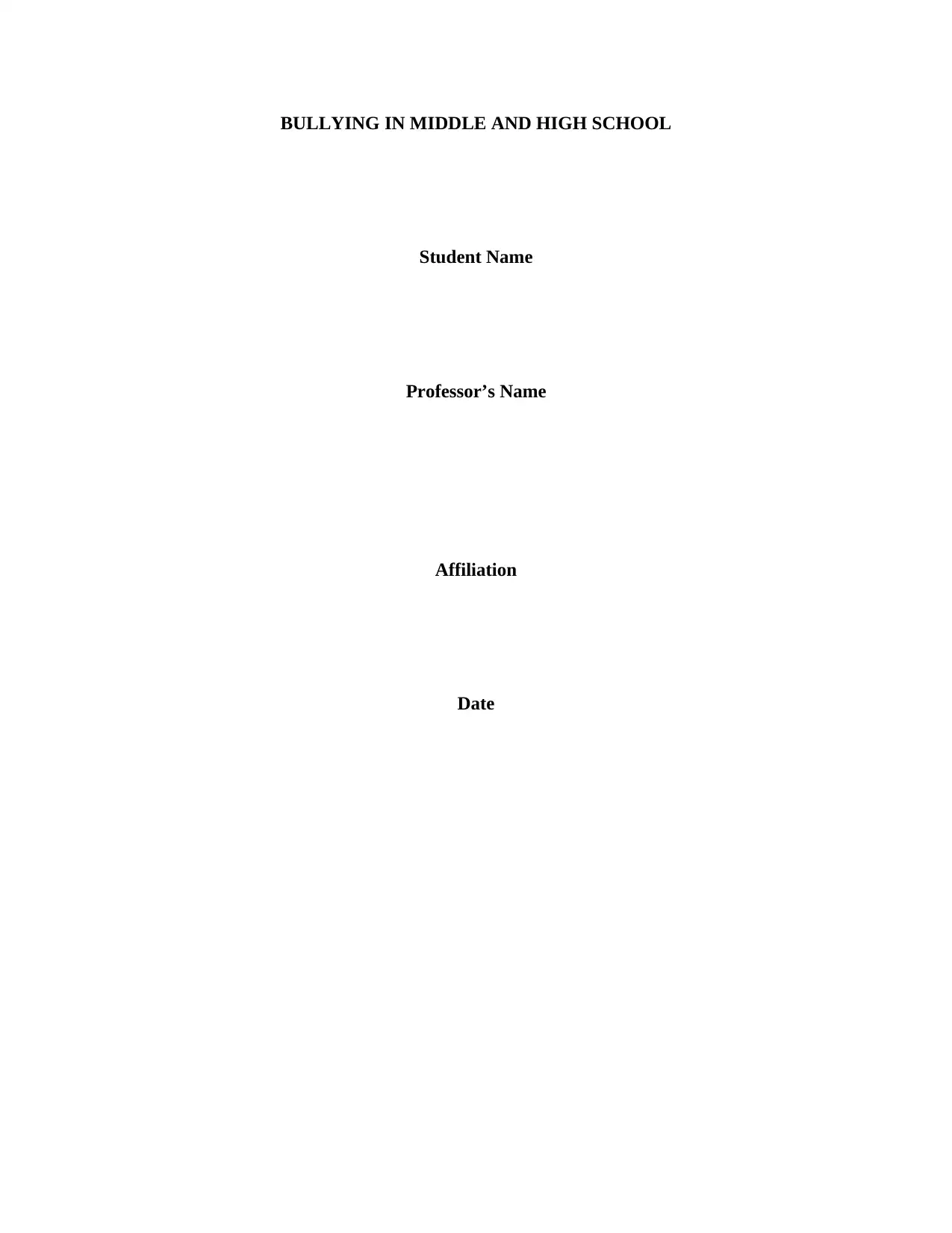
BULLYING IN MIDDLE AND HIGH SCHOOL
Student Name
Professor’s Name
Affiliation
Date
Student Name
Professor’s Name
Affiliation
Date
Secure Best Marks with AI Grader
Need help grading? Try our AI Grader for instant feedback on your assignments.
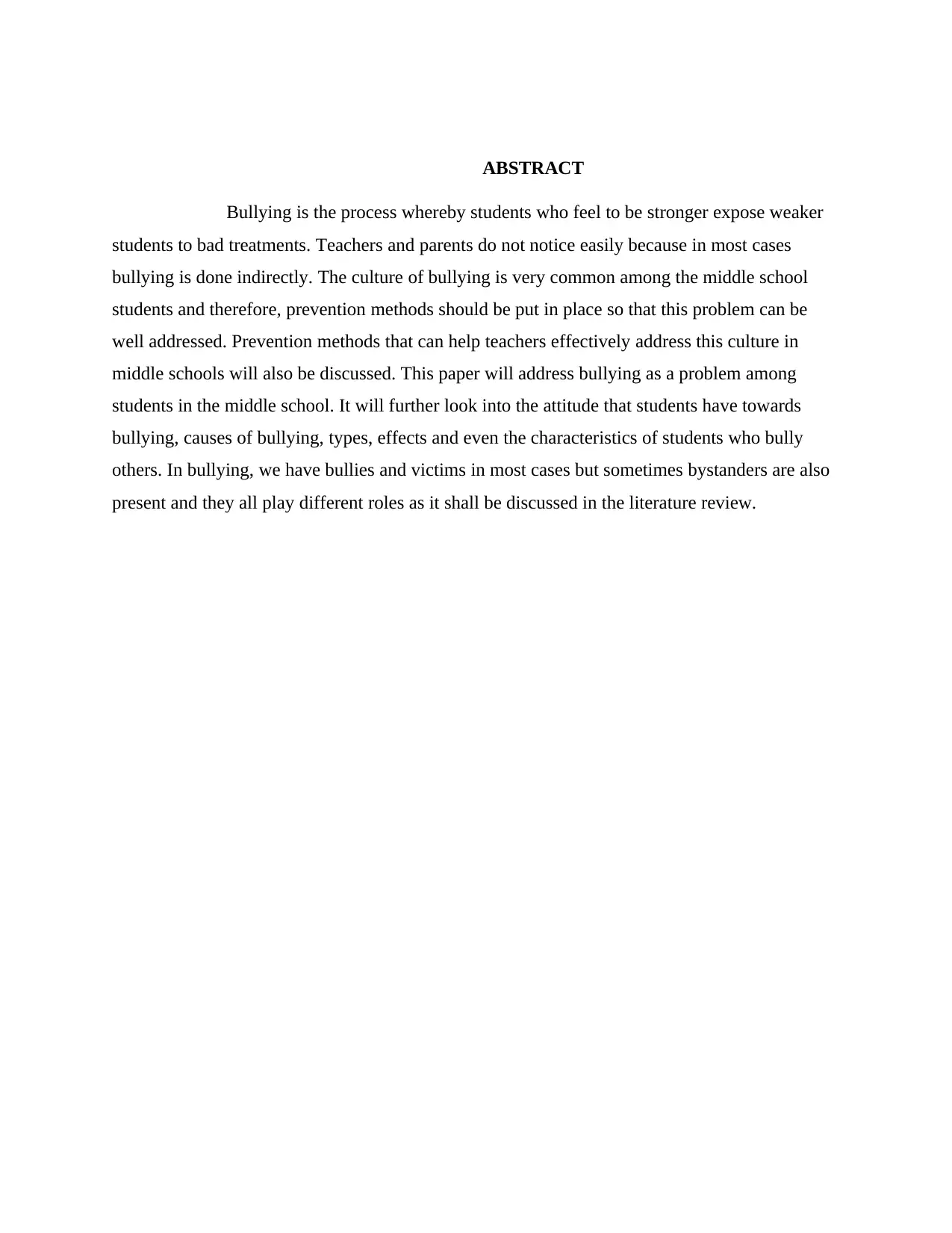
ABSTRACT
Bullying is the process whereby students who feel to be stronger expose weaker
students to bad treatments. Teachers and parents do not notice easily because in most cases
bullying is done indirectly. The culture of bullying is very common among the middle school
students and therefore, prevention methods should be put in place so that this problem can be
well addressed. Prevention methods that can help teachers effectively address this culture in
middle schools will also be discussed. This paper will address bullying as a problem among
students in the middle school. It will further look into the attitude that students have towards
bullying, causes of bullying, types, effects and even the characteristics of students who bully
others. In bullying, we have bullies and victims in most cases but sometimes bystanders are also
present and they all play different roles as it shall be discussed in the literature review.
Bullying is the process whereby students who feel to be stronger expose weaker
students to bad treatments. Teachers and parents do not notice easily because in most cases
bullying is done indirectly. The culture of bullying is very common among the middle school
students and therefore, prevention methods should be put in place so that this problem can be
well addressed. Prevention methods that can help teachers effectively address this culture in
middle schools will also be discussed. This paper will address bullying as a problem among
students in the middle school. It will further look into the attitude that students have towards
bullying, causes of bullying, types, effects and even the characteristics of students who bully
others. In bullying, we have bullies and victims in most cases but sometimes bystanders are also
present and they all play different roles as it shall be discussed in the literature review.
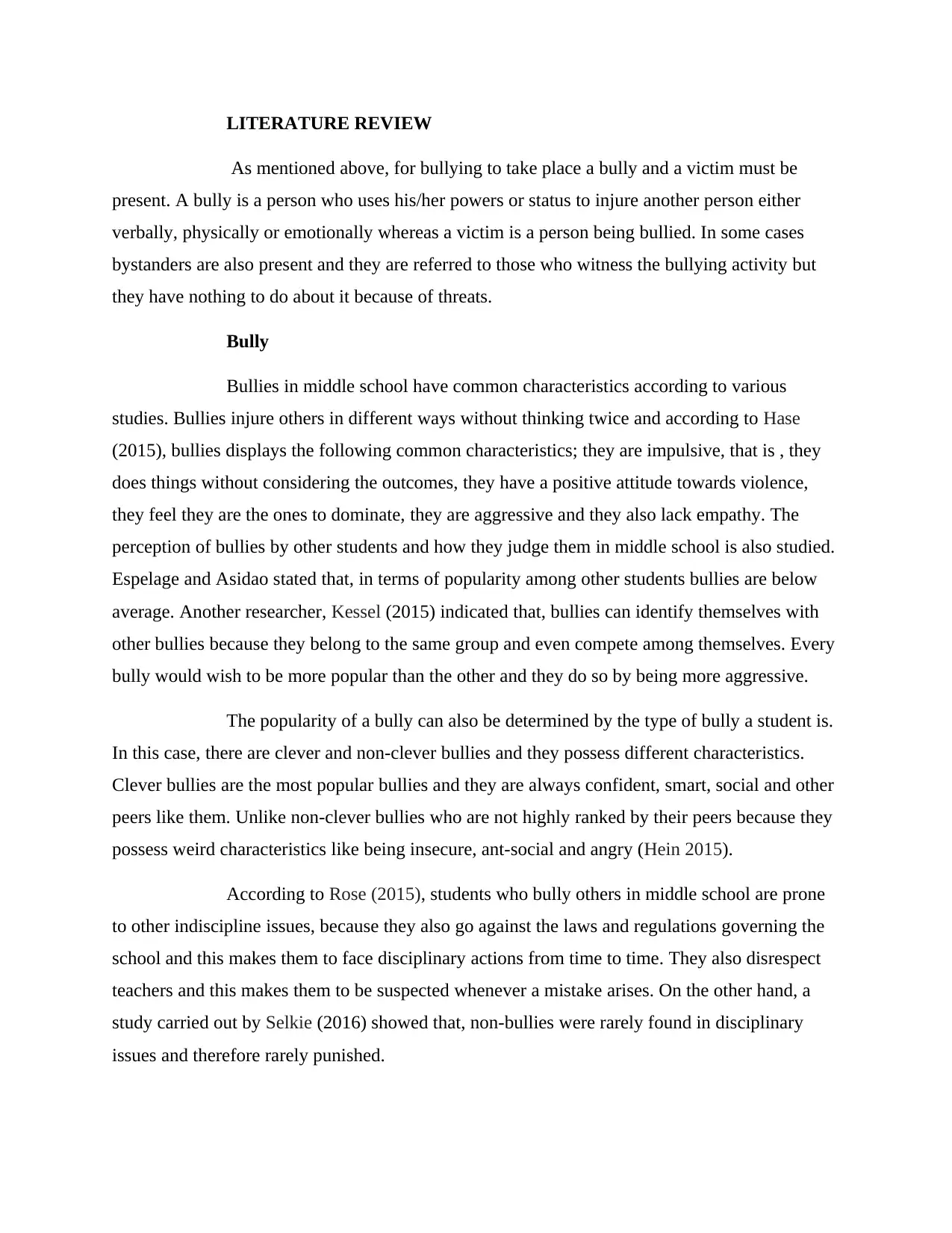
LITERATURE REVIEW
As mentioned above, for bullying to take place a bully and a victim must be
present. A bully is a person who uses his/her powers or status to injure another person either
verbally, physically or emotionally whereas a victim is a person being bullied. In some cases
bystanders are also present and they are referred to those who witness the bullying activity but
they have nothing to do about it because of threats.
Bully
Bullies in middle school have common characteristics according to various
studies. Bullies injure others in different ways without thinking twice and according to Hase
(2015), bullies displays the following common characteristics; they are impulsive, that is , they
does things without considering the outcomes, they have a positive attitude towards violence,
they feel they are the ones to dominate, they are aggressive and they also lack empathy. The
perception of bullies by other students and how they judge them in middle school is also studied.
Espelage and Asidao stated that, in terms of popularity among other students bullies are below
average. Another researcher, Kessel (2015) indicated that, bullies can identify themselves with
other bullies because they belong to the same group and even compete among themselves. Every
bully would wish to be more popular than the other and they do so by being more aggressive.
The popularity of a bully can also be determined by the type of bully a student is.
In this case, there are clever and non-clever bullies and they possess different characteristics.
Clever bullies are the most popular bullies and they are always confident, smart, social and other
peers like them. Unlike non-clever bullies who are not highly ranked by their peers because they
possess weird characteristics like being insecure, ant-social and angry (Hein 2015).
According to Rose (2015), students who bully others in middle school are prone
to other indiscipline issues, because they also go against the laws and regulations governing the
school and this makes them to face disciplinary actions from time to time. They also disrespect
teachers and this makes them to be suspected whenever a mistake arises. On the other hand, a
study carried out by Selkie (2016) showed that, non-bullies were rarely found in disciplinary
issues and therefore rarely punished.
As mentioned above, for bullying to take place a bully and a victim must be
present. A bully is a person who uses his/her powers or status to injure another person either
verbally, physically or emotionally whereas a victim is a person being bullied. In some cases
bystanders are also present and they are referred to those who witness the bullying activity but
they have nothing to do about it because of threats.
Bully
Bullies in middle school have common characteristics according to various
studies. Bullies injure others in different ways without thinking twice and according to Hase
(2015), bullies displays the following common characteristics; they are impulsive, that is , they
does things without considering the outcomes, they have a positive attitude towards violence,
they feel they are the ones to dominate, they are aggressive and they also lack empathy. The
perception of bullies by other students and how they judge them in middle school is also studied.
Espelage and Asidao stated that, in terms of popularity among other students bullies are below
average. Another researcher, Kessel (2015) indicated that, bullies can identify themselves with
other bullies because they belong to the same group and even compete among themselves. Every
bully would wish to be more popular than the other and they do so by being more aggressive.
The popularity of a bully can also be determined by the type of bully a student is.
In this case, there are clever and non-clever bullies and they possess different characteristics.
Clever bullies are the most popular bullies and they are always confident, smart, social and other
peers like them. Unlike non-clever bullies who are not highly ranked by their peers because they
possess weird characteristics like being insecure, ant-social and angry (Hein 2015).
According to Rose (2015), students who bully others in middle school are prone
to other indiscipline issues, because they also go against the laws and regulations governing the
school and this makes them to face disciplinary actions from time to time. They also disrespect
teachers and this makes them to be suspected whenever a mistake arises. On the other hand, a
study carried out by Selkie (2016) showed that, non-bullies were rarely found in disciplinary
issues and therefore rarely punished.
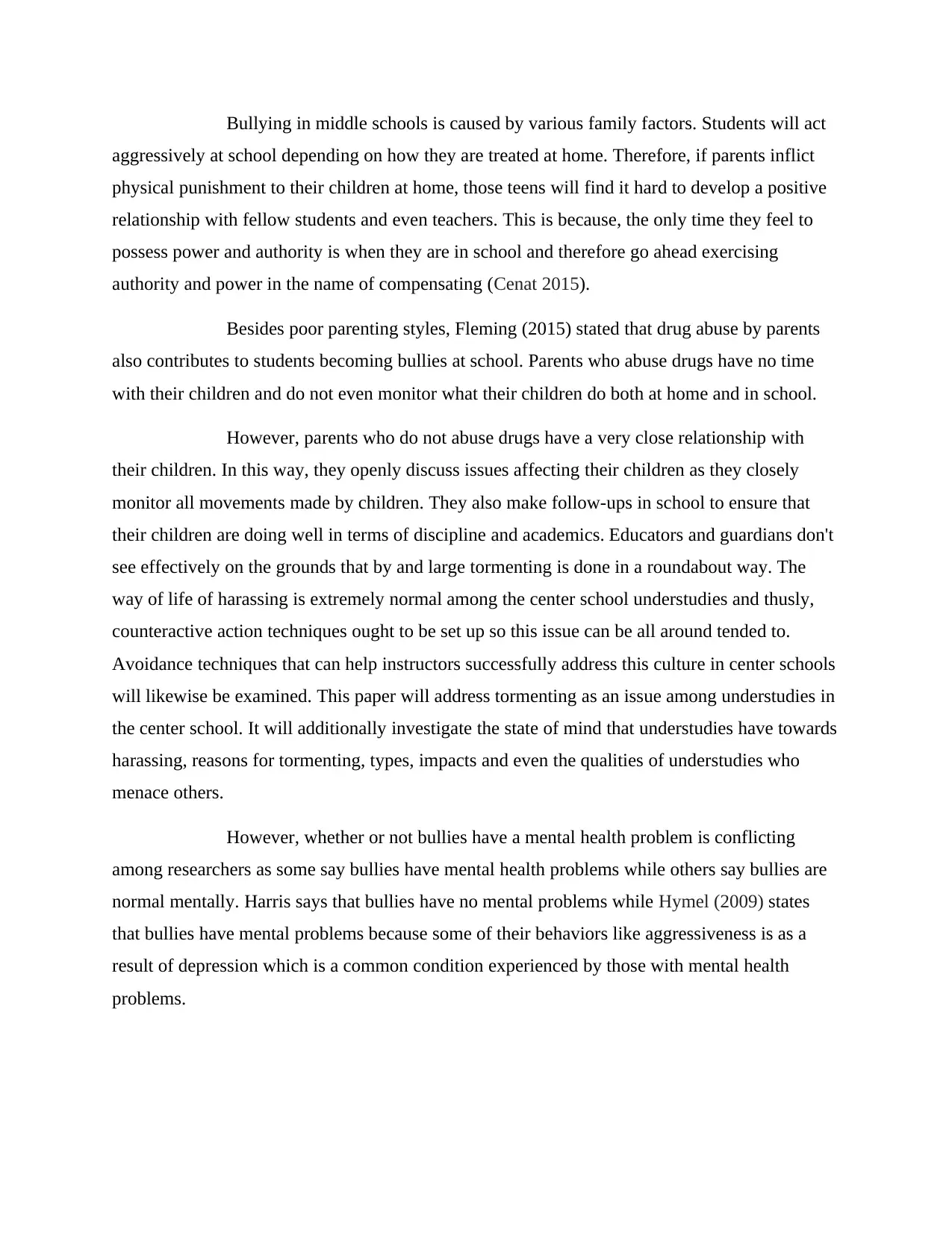
Bullying in middle schools is caused by various family factors. Students will act
aggressively at school depending on how they are treated at home. Therefore, if parents inflict
physical punishment to their children at home, those teens will find it hard to develop a positive
relationship with fellow students and even teachers. This is because, the only time they feel to
possess power and authority is when they are in school and therefore go ahead exercising
authority and power in the name of compensating (Cenat 2015).
Besides poor parenting styles, Fleming (2015) stated that drug abuse by parents
also contributes to students becoming bullies at school. Parents who abuse drugs have no time
with their children and do not even monitor what their children do both at home and in school.
However, parents who do not abuse drugs have a very close relationship with
their children. In this way, they openly discuss issues affecting their children as they closely
monitor all movements made by children. They also make follow-ups in school to ensure that
their children are doing well in terms of discipline and academics. Educators and guardians don't
see effectively on the grounds that by and large tormenting is done in a roundabout way. The
way of life of harassing is extremely normal among the center school understudies and thusly,
counteractive action techniques ought to be set up so this issue can be all around tended to.
Avoidance techniques that can help instructors successfully address this culture in center schools
will likewise be examined. This paper will address tormenting as an issue among understudies in
the center school. It will additionally investigate the state of mind that understudies have towards
harassing, reasons for tormenting, types, impacts and even the qualities of understudies who
menace others.
However, whether or not bullies have a mental health problem is conflicting
among researchers as some say bullies have mental health problems while others say bullies are
normal mentally. Harris says that bullies have no mental problems while Hymel (2009) states
that bullies have mental problems because some of their behaviors like aggressiveness is as a
result of depression which is a common condition experienced by those with mental health
problems.
aggressively at school depending on how they are treated at home. Therefore, if parents inflict
physical punishment to their children at home, those teens will find it hard to develop a positive
relationship with fellow students and even teachers. This is because, the only time they feel to
possess power and authority is when they are in school and therefore go ahead exercising
authority and power in the name of compensating (Cenat 2015).
Besides poor parenting styles, Fleming (2015) stated that drug abuse by parents
also contributes to students becoming bullies at school. Parents who abuse drugs have no time
with their children and do not even monitor what their children do both at home and in school.
However, parents who do not abuse drugs have a very close relationship with
their children. In this way, they openly discuss issues affecting their children as they closely
monitor all movements made by children. They also make follow-ups in school to ensure that
their children are doing well in terms of discipline and academics. Educators and guardians don't
see effectively on the grounds that by and large tormenting is done in a roundabout way. The
way of life of harassing is extremely normal among the center school understudies and thusly,
counteractive action techniques ought to be set up so this issue can be all around tended to.
Avoidance techniques that can help instructors successfully address this culture in center schools
will likewise be examined. This paper will address tormenting as an issue among understudies in
the center school. It will additionally investigate the state of mind that understudies have towards
harassing, reasons for tormenting, types, impacts and even the qualities of understudies who
menace others.
However, whether or not bullies have a mental health problem is conflicting
among researchers as some say bullies have mental health problems while others say bullies are
normal mentally. Harris says that bullies have no mental problems while Hymel (2009) states
that bullies have mental problems because some of their behaviors like aggressiveness is as a
result of depression which is a common condition experienced by those with mental health
problems.
Secure Best Marks with AI Grader
Need help grading? Try our AI Grader for instant feedback on your assignments.
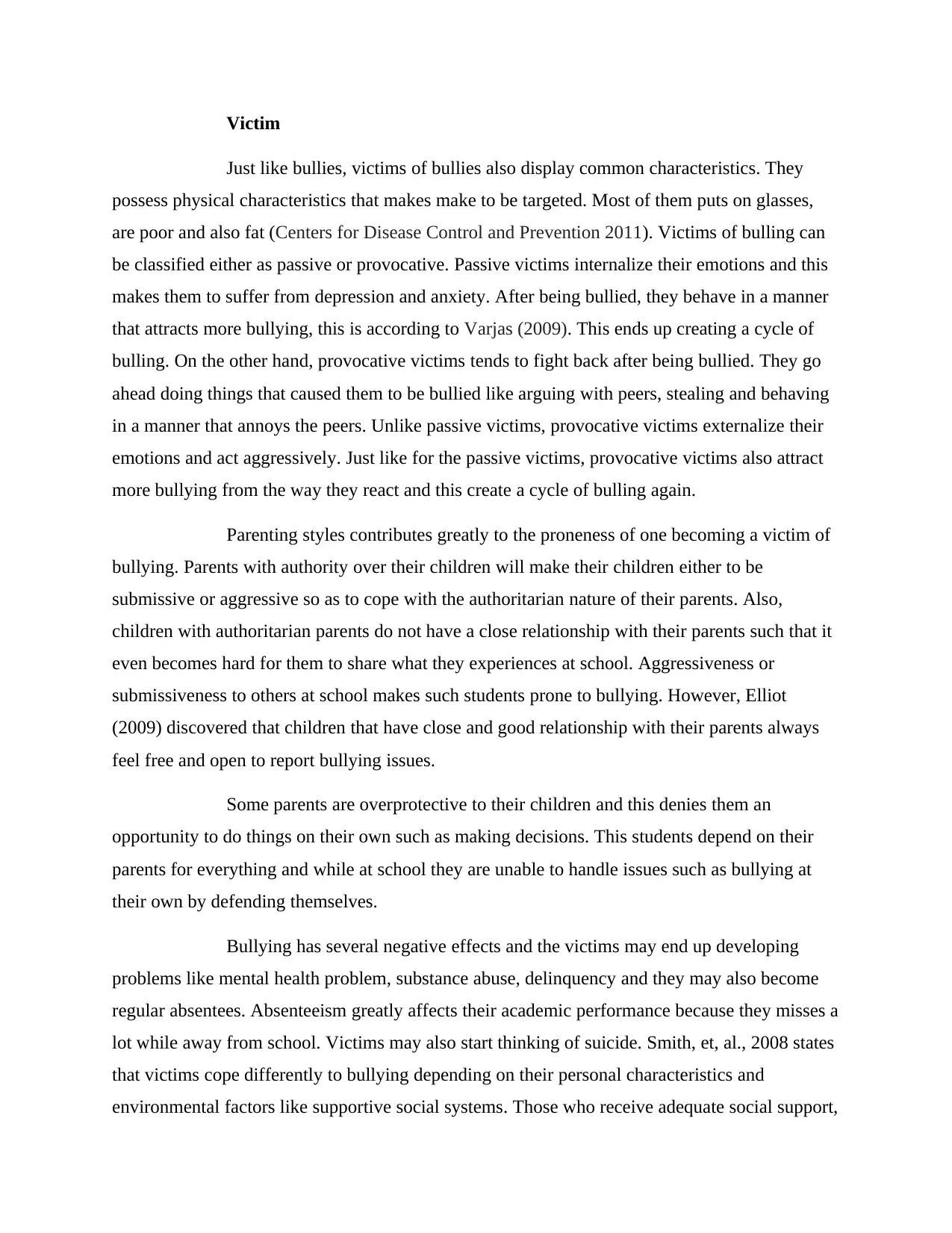
Victim
Just like bullies, victims of bullies also display common characteristics. They
possess physical characteristics that makes make to be targeted. Most of them puts on glasses,
are poor and also fat (Centers for Disease Control and Prevention 2011). Victims of bulling can
be classified either as passive or provocative. Passive victims internalize their emotions and this
makes them to suffer from depression and anxiety. After being bullied, they behave in a manner
that attracts more bullying, this is according to Varjas (2009). This ends up creating a cycle of
bulling. On the other hand, provocative victims tends to fight back after being bullied. They go
ahead doing things that caused them to be bullied like arguing with peers, stealing and behaving
in a manner that annoys the peers. Unlike passive victims, provocative victims externalize their
emotions and act aggressively. Just like for the passive victims, provocative victims also attract
more bullying from the way they react and this create a cycle of bulling again.
Parenting styles contributes greatly to the proneness of one becoming a victim of
bullying. Parents with authority over their children will make their children either to be
submissive or aggressive so as to cope with the authoritarian nature of their parents. Also,
children with authoritarian parents do not have a close relationship with their parents such that it
even becomes hard for them to share what they experiences at school. Aggressiveness or
submissiveness to others at school makes such students prone to bullying. However, Elliot
(2009) discovered that children that have close and good relationship with their parents always
feel free and open to report bullying issues.
Some parents are overprotective to their children and this denies them an
opportunity to do things on their own such as making decisions. This students depend on their
parents for everything and while at school they are unable to handle issues such as bullying at
their own by defending themselves.
Bullying has several negative effects and the victims may end up developing
problems like mental health problem, substance abuse, delinquency and they may also become
regular absentees. Absenteeism greatly affects their academic performance because they misses a
lot while away from school. Victims may also start thinking of suicide. Smith, et, al., 2008 states
that victims cope differently to bullying depending on their personal characteristics and
environmental factors like supportive social systems. Those who receive adequate social support,
Just like bullies, victims of bullies also display common characteristics. They
possess physical characteristics that makes make to be targeted. Most of them puts on glasses,
are poor and also fat (Centers for Disease Control and Prevention 2011). Victims of bulling can
be classified either as passive or provocative. Passive victims internalize their emotions and this
makes them to suffer from depression and anxiety. After being bullied, they behave in a manner
that attracts more bullying, this is according to Varjas (2009). This ends up creating a cycle of
bulling. On the other hand, provocative victims tends to fight back after being bullied. They go
ahead doing things that caused them to be bullied like arguing with peers, stealing and behaving
in a manner that annoys the peers. Unlike passive victims, provocative victims externalize their
emotions and act aggressively. Just like for the passive victims, provocative victims also attract
more bullying from the way they react and this create a cycle of bulling again.
Parenting styles contributes greatly to the proneness of one becoming a victim of
bullying. Parents with authority over their children will make their children either to be
submissive or aggressive so as to cope with the authoritarian nature of their parents. Also,
children with authoritarian parents do not have a close relationship with their parents such that it
even becomes hard for them to share what they experiences at school. Aggressiveness or
submissiveness to others at school makes such students prone to bullying. However, Elliot
(2009) discovered that children that have close and good relationship with their parents always
feel free and open to report bullying issues.
Some parents are overprotective to their children and this denies them an
opportunity to do things on their own such as making decisions. This students depend on their
parents for everything and while at school they are unable to handle issues such as bullying at
their own by defending themselves.
Bullying has several negative effects and the victims may end up developing
problems like mental health problem, substance abuse, delinquency and they may also become
regular absentees. Absenteeism greatly affects their academic performance because they misses a
lot while away from school. Victims may also start thinking of suicide. Smith, et, al., 2008 states
that victims cope differently to bullying depending on their personal characteristics and
environmental factors like supportive social systems. Those who receive adequate social support,
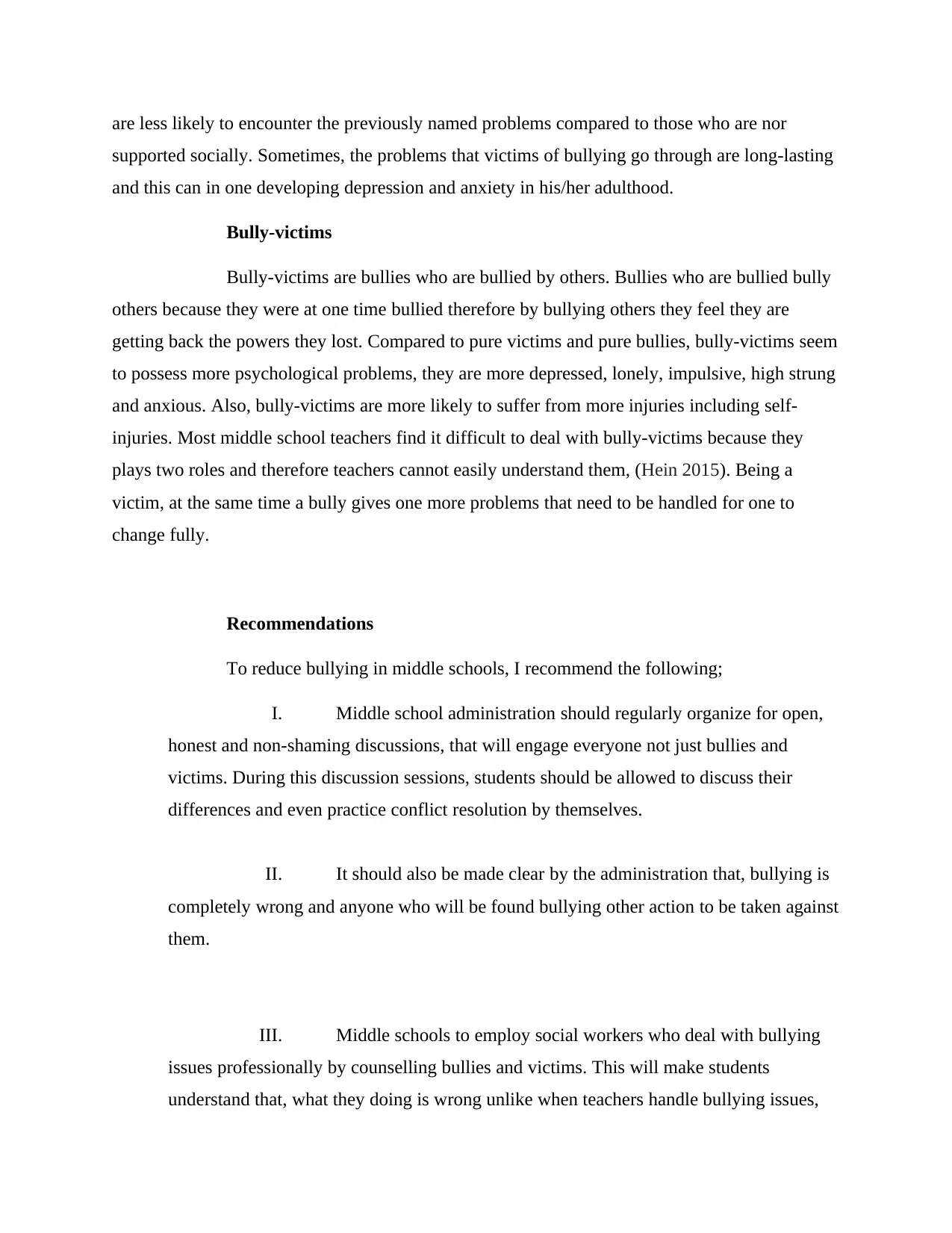
are less likely to encounter the previously named problems compared to those who are nor
supported socially. Sometimes, the problems that victims of bullying go through are long-lasting
and this can in one developing depression and anxiety in his/her adulthood.
Bully-victims
Bully-victims are bullies who are bullied by others. Bullies who are bullied bully
others because they were at one time bullied therefore by bullying others they feel they are
getting back the powers they lost. Compared to pure victims and pure bullies, bully-victims seem
to possess more psychological problems, they are more depressed, lonely, impulsive, high strung
and anxious. Also, bully-victims are more likely to suffer from more injuries including self-
injuries. Most middle school teachers find it difficult to deal with bully-victims because they
plays two roles and therefore teachers cannot easily understand them, (Hein 2015). Being a
victim, at the same time a bully gives one more problems that need to be handled for one to
change fully.
Recommendations
To reduce bullying in middle schools, I recommend the following;
I. Middle school administration should regularly organize for open,
honest and non-shaming discussions, that will engage everyone not just bullies and
victims. During this discussion sessions, students should be allowed to discuss their
differences and even practice conflict resolution by themselves.
II. It should also be made clear by the administration that, bullying is
completely wrong and anyone who will be found bullying other action to be taken against
them.
III. Middle schools to employ social workers who deal with bullying
issues professionally by counselling bullies and victims. This will make students
understand that, what they doing is wrong unlike when teachers handle bullying issues,
supported socially. Sometimes, the problems that victims of bullying go through are long-lasting
and this can in one developing depression and anxiety in his/her adulthood.
Bully-victims
Bully-victims are bullies who are bullied by others. Bullies who are bullied bully
others because they were at one time bullied therefore by bullying others they feel they are
getting back the powers they lost. Compared to pure victims and pure bullies, bully-victims seem
to possess more psychological problems, they are more depressed, lonely, impulsive, high strung
and anxious. Also, bully-victims are more likely to suffer from more injuries including self-
injuries. Most middle school teachers find it difficult to deal with bully-victims because they
plays two roles and therefore teachers cannot easily understand them, (Hein 2015). Being a
victim, at the same time a bully gives one more problems that need to be handled for one to
change fully.
Recommendations
To reduce bullying in middle schools, I recommend the following;
I. Middle school administration should regularly organize for open,
honest and non-shaming discussions, that will engage everyone not just bullies and
victims. During this discussion sessions, students should be allowed to discuss their
differences and even practice conflict resolution by themselves.
II. It should also be made clear by the administration that, bullying is
completely wrong and anyone who will be found bullying other action to be taken against
them.
III. Middle schools to employ social workers who deal with bullying
issues professionally by counselling bullies and victims. This will make students
understand that, what they doing is wrong unlike when teachers handle bullying issues,
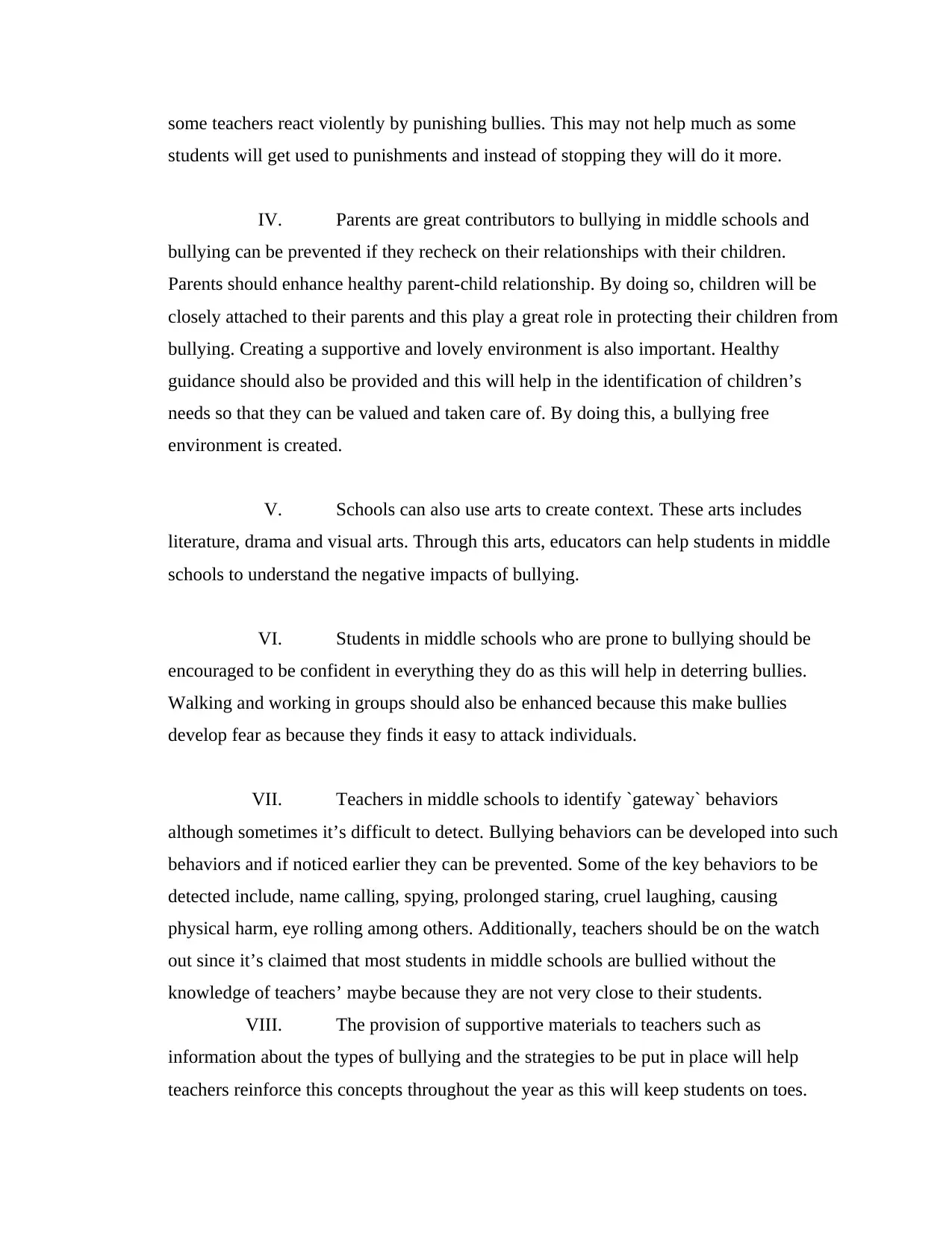
some teachers react violently by punishing bullies. This may not help much as some
students will get used to punishments and instead of stopping they will do it more.
IV. Parents are great contributors to bullying in middle schools and
bullying can be prevented if they recheck on their relationships with their children.
Parents should enhance healthy parent-child relationship. By doing so, children will be
closely attached to their parents and this play a great role in protecting their children from
bullying. Creating a supportive and lovely environment is also important. Healthy
guidance should also be provided and this will help in the identification of children’s
needs so that they can be valued and taken care of. By doing this, a bullying free
environment is created.
V. Schools can also use arts to create context. These arts includes
literature, drama and visual arts. Through this arts, educators can help students in middle
schools to understand the negative impacts of bullying.
VI. Students in middle schools who are prone to bullying should be
encouraged to be confident in everything they do as this will help in deterring bullies.
Walking and working in groups should also be enhanced because this make bullies
develop fear as because they finds it easy to attack individuals.
VII. Teachers in middle schools to identify `gateway` behaviors
although sometimes it’s difficult to detect. Bullying behaviors can be developed into such
behaviors and if noticed earlier they can be prevented. Some of the key behaviors to be
detected include, name calling, spying, prolonged staring, cruel laughing, causing
physical harm, eye rolling among others. Additionally, teachers should be on the watch
out since it’s claimed that most students in middle schools are bullied without the
knowledge of teachers’ maybe because they are not very close to their students.
VIII. The provision of supportive materials to teachers such as
information about the types of bullying and the strategies to be put in place will help
teachers reinforce this concepts throughout the year as this will keep students on toes.
students will get used to punishments and instead of stopping they will do it more.
IV. Parents are great contributors to bullying in middle schools and
bullying can be prevented if they recheck on their relationships with their children.
Parents should enhance healthy parent-child relationship. By doing so, children will be
closely attached to their parents and this play a great role in protecting their children from
bullying. Creating a supportive and lovely environment is also important. Healthy
guidance should also be provided and this will help in the identification of children’s
needs so that they can be valued and taken care of. By doing this, a bullying free
environment is created.
V. Schools can also use arts to create context. These arts includes
literature, drama and visual arts. Through this arts, educators can help students in middle
schools to understand the negative impacts of bullying.
VI. Students in middle schools who are prone to bullying should be
encouraged to be confident in everything they do as this will help in deterring bullies.
Walking and working in groups should also be enhanced because this make bullies
develop fear as because they finds it easy to attack individuals.
VII. Teachers in middle schools to identify `gateway` behaviors
although sometimes it’s difficult to detect. Bullying behaviors can be developed into such
behaviors and if noticed earlier they can be prevented. Some of the key behaviors to be
detected include, name calling, spying, prolonged staring, cruel laughing, causing
physical harm, eye rolling among others. Additionally, teachers should be on the watch
out since it’s claimed that most students in middle schools are bullied without the
knowledge of teachers’ maybe because they are not very close to their students.
VIII. The provision of supportive materials to teachers such as
information about the types of bullying and the strategies to be put in place will help
teachers reinforce this concepts throughout the year as this will keep students on toes.
Paraphrase This Document
Need a fresh take? Get an instant paraphrase of this document with our AI Paraphraser
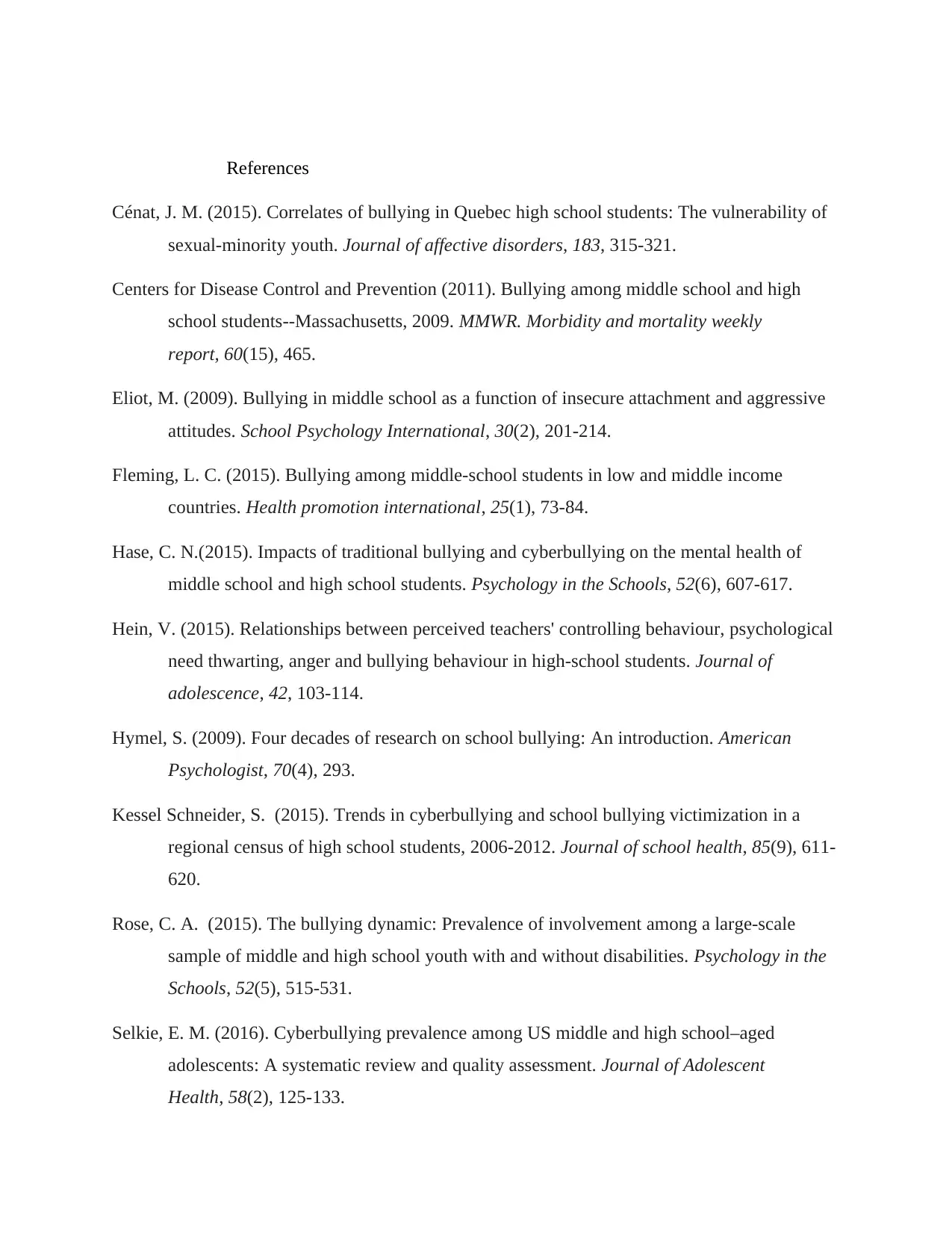
References
Cénat, J. M. (2015). Correlates of bullying in Quebec high school students: The vulnerability of
sexual-minority youth. Journal of affective disorders, 183, 315-321.
Centers for Disease Control and Prevention (2011). Bullying among middle school and high
school students--Massachusetts, 2009. MMWR. Morbidity and mortality weekly
report, 60(15), 465.
Eliot, M. (2009). Bullying in middle school as a function of insecure attachment and aggressive
attitudes. School Psychology International, 30(2), 201-214.
Fleming, L. C. (2015). Bullying among middle-school students in low and middle income
countries. Health promotion international, 25(1), 73-84.
Hase, C. N.(2015). Impacts of traditional bullying and cyberbullying on the mental health of
middle school and high school students. Psychology in the Schools, 52(6), 607-617.
Hein, V. (2015). Relationships between perceived teachers' controlling behaviour, psychological
need thwarting, anger and bullying behaviour in high-school students. Journal of
adolescence, 42, 103-114.
Hymel, S. (2009). Four decades of research on school bullying: An introduction. American
Psychologist, 70(4), 293.
Kessel Schneider, S. (2015). Trends in cyberbullying and school bullying victimization in a
regional census of high school students, 2006‐2012. Journal of school health, 85(9), 611-
620.
Rose, C. A. (2015). The bullying dynamic: Prevalence of involvement among a large‐scale
sample of middle and high school youth with and without disabilities. Psychology in the
Schools, 52(5), 515-531.
Selkie, E. M. (2016). Cyberbullying prevalence among US middle and high school–aged
adolescents: A systematic review and quality assessment. Journal of Adolescent
Health, 58(2), 125-133.
Cénat, J. M. (2015). Correlates of bullying in Quebec high school students: The vulnerability of
sexual-minority youth. Journal of affective disorders, 183, 315-321.
Centers for Disease Control and Prevention (2011). Bullying among middle school and high
school students--Massachusetts, 2009. MMWR. Morbidity and mortality weekly
report, 60(15), 465.
Eliot, M. (2009). Bullying in middle school as a function of insecure attachment and aggressive
attitudes. School Psychology International, 30(2), 201-214.
Fleming, L. C. (2015). Bullying among middle-school students in low and middle income
countries. Health promotion international, 25(1), 73-84.
Hase, C. N.(2015). Impacts of traditional bullying and cyberbullying on the mental health of
middle school and high school students. Psychology in the Schools, 52(6), 607-617.
Hein, V. (2015). Relationships between perceived teachers' controlling behaviour, psychological
need thwarting, anger and bullying behaviour in high-school students. Journal of
adolescence, 42, 103-114.
Hymel, S. (2009). Four decades of research on school bullying: An introduction. American
Psychologist, 70(4), 293.
Kessel Schneider, S. (2015). Trends in cyberbullying and school bullying victimization in a
regional census of high school students, 2006‐2012. Journal of school health, 85(9), 611-
620.
Rose, C. A. (2015). The bullying dynamic: Prevalence of involvement among a large‐scale
sample of middle and high school youth with and without disabilities. Psychology in the
Schools, 52(5), 515-531.
Selkie, E. M. (2016). Cyberbullying prevalence among US middle and high school–aged
adolescents: A systematic review and quality assessment. Journal of Adolescent
Health, 58(2), 125-133.

Varjas, K. (2009). Urban middle school students' perceptions of bullying, cyberbullying, and
school safety. Journal of School Violence, 8(2), 159-176.
school safety. Journal of School Violence, 8(2), 159-176.
1 out of 9
Related Documents
Your All-in-One AI-Powered Toolkit for Academic Success.
+13062052269
info@desklib.com
Available 24*7 on WhatsApp / Email
![[object Object]](/_next/static/media/star-bottom.7253800d.svg)
Unlock your academic potential
© 2024 | Zucol Services PVT LTD | All rights reserved.





